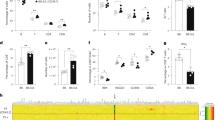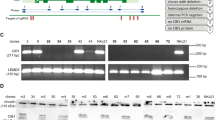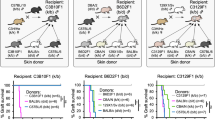Abstract
Cultured keratinocyte allografts from unrelated donors can be readily grown as sheets in large-scale cell culture and have been used as an immediate skin cover for severely burned patients. Despite the absence of passenger leukocytes and the unlimited amount of material that can be obtained for permanent skin coverage, the allografts are susceptible to rejection. Since MHC class I (MHCI) antigens serve as targets for allograft rejection, we investigated whether ‘phenotypic knockout’ of human MHCI could be achieved through expression of an ER-directed anti-human MHCI single-chain intrabody (sFvhMHCI) that is directed against a monomorphic, conformational epitope, expressed across species lines, on the MHCI heavy chain. Co-immunoprecipitation of both MHCI heavy chain and β2-microglobulin occurred in transfected monkey COS-1 cells, while Jurkat T cells stably expressing the ER-directed sFvhMHCI intrabody showed that complete phenotypic knockout of MHCI cell surface expression could be achieved. Infection of several human cell lines of divergent tissue sources and different HLA haplotypes resulted in marked down-regulation of MHCI expression, even under conditions where inflammatory cytokines (eg γ-IFN) which up-regulate MHCI expression were used. Finally, when adenovirus encoding the anti-human MHCI intrabody was used to transduce primary human keratinocytes, a marked reduction of surface MHCI expression was observed. These in vitro studies set the groundwork for in vivo studies to determine if intrabody-mediated knockout of MHCI can impair alloantigen expression and prolong the survival of keratinocyte allografts.
This is a preview of subscription content, access via your institution
Access options
Subscribe to this journal
Receive 12 print issues and online access
$259.00 per year
only $21.58 per issue
Buy this article
- Purchase on Springer Link
- Instant access to full article PDF
Prices may be subject to local taxes which are calculated during checkout







Similar content being viewed by others
References
Robert C., Kupper T.S. . Inflammatory skin diseases, T cells and immune surveillance Mech Dis 1999 341: 1817 1817
Reinwald J.G., Green H. . Serial cultivation of strains of human epidermal keratinocytes: the formation of keratinizing colonies from single cells Cell 1975 6: 331 331
O'Connor N.E. et al. Grafting of burns with cultured epithelium prepared from autologous epidermal cells Lancet 1981 1: 75 75
Hefton J.M., Madden M.R., Finkelstein J.L., Shires G.T. . Grafting of burn patients with allografts of cultured epidermal cells Lancet 1983 2: 428 428
Madden M.R. et al. Grating of cultured allogeneic epidermis on second- and third-degree burn wounds on 26 patients J Trauma 1986 26: 955 955
Malakhov S.F., Paramonov B.A., Vasiliev A.V., Terskikh V.V. . Preliminary report of the clinical use of cultured allogeneic keratinocytes Burns 1994 20: 463 463
Thiovolet J., Faure M., Demidem A., Mauduit G. . Cultured human epidermal allografts are not rejected for a long period Arch Dermatol Res 1986 278: 252 252
Thiovolet J., Faure M., Demidem A., Mauduit G. . Long-term survival and immunological tolerance of human epidermal allografts produced in culture Transplantation 1986 42: 274 274
Gielen V., Faure M., Mauduit G., Thiovolet J. . Progressive replacement of human cultured epithelial allografts by recipient cells as evidenced by HLA class 1 antigen expression Dermatologica 1987 175: 166 166
De Luca M. et al. Multicentre experience in the treatment of burns with autologous and allogenic cultured epithelium, fresh or preserved in a frozen state Burns 1989 15: 303 303
Burt A.M. et al. Survival of cultured allografts in patients with burns assessed with probe specific for Y chromosome Br Med J 1989 298: 915 915
Brain A. et al. Survival of cultured allogeneic keratinocytes transplanted to deep dermal bed assessed with probe specific for Y chromosome Br Med J 1989 298: 917 917
Van Der Merwe A.E., Mattheyse F.J., Van Helden P.D., Rossouw D.J. . Allografted keratinocytes used to accelerate the treatment of burn wounds are replaced by recipient cells Burns 1990 16: 193 193
Morhenn V.B., Nickoloff B.J. . Interleukin-2 stimulates resting human T lymphocytes’ response to allogeneic, gamma interferon-treated keratinocytes J Invest Dermatol 1987 489: 464 464
Niederwieser D. et al. IFN-mediated induction of MHC antigen expression on human keratinocytes and its influence on in vitro alloimmune responses J Immunol 1988 140: 2556 2556
Theobald V.A. et al. ‘Neutral allograft’ - lack of allogeneic stimulation by cultured human cells expressing MHC class I and II antigens Transplantation 1993 55: 128 128
Bjorkman P.J. et al. Structure of the human class I histocompatibility antigen, HLA-A2 Nature 1987 329: 506 506
Parham P. . Function and polymorphism of human leukocyte antigen-A, B, C molecules Am J Med 1988 85: 2 2
Yokoyama K., Geier S.S., Uchara H., Nathenson S.G. . Secondary structure of the murine histocompatibility alloantigen H-2Kb: relationship between heavy chain, β2-microglobulin, and antigenic reactivity Biochemistry 1985 24: 3002 3002
Danliczyk U.G., Delovitch T.L. . β2-microglobulin induces a conformational change in an MHC class I H chain that occurs intracellularly and is maintained at the cell surface J Immunol 1994 153: 3533 3533
Townsend A., Bodmer H.A. . Antigen recognition by class I-restricted T-lymphocytes Annu Rev Immunol 1989 7: 601 601
Elliot T., Cerundolo V., Elvin J., Townsend A. . Peptide-induced conformational change of the class I heavy chain Nature 1991 351: 402 402
Rotzschke O. et al. Isolation and analysis of naturally processed viral peptides as recognized by cytotoxic T cells Nature 1990 348: 252 252
Rock K.L. . A new foreign policy: MHC class I molecules monitor the outside world Immunol Today 1996 17: 131 131
Lee R.S. et al. CD8+ effector cells responding to residual class I antigens, with help from CD4+ cells stimulated indirectly, cause rejection of ‘major histocompatibility complex-deficient’ skin grafts Transplantation 1997 63: 1123 1123
Brodsky F.M. et al. Monoclonal antibodies for analysis of the HLA system Immunol Rev 1979 47: 3 3
Brodsky F.M., Parham P. . Monomorphic anti-HLA-A, B, C monoclonal antibodies detecting molecular subunits and combinatorial determinants J Immunol 1982 128: 129 129
Brodsky F.M., Parham P. . Evolution of HLA antigenic determinants: species cross-reactions of monoclonal antibodies Immunogenetics 1982 15: 151 151
Carroll W.L., Mendel E., Levy S. . Hybridoma fusion cell lines contain an aberrant kappa transcript Mol Immunol 1988 25: 991 991
Duan L., Pomerantz R.J. . Elimination of endogenous aberrant kappa chain transcripts from sp2/0-derived hybridoma cells by specific ribozyme cleavage: utility in genetic therapy of HIV-1 infections Nucleic Acids Res 1994 22: 5433 5433
Krebber A. et al. Reliable cloning of functional antibody variable domains from hybridomas and spleen cell repertoires employing a reengineered phage display system J Immunol Meth 1997 201: 35 35
Krebber A. et al. Reliable cloning of functional antibody variable domains from hybridomas and spleen cell repertoires employing a reengineered phage display system
Tomlinson IM et al.. V BASE Sequence Directory. MRC Centre for Protein Engineering, Cambridge, 1996. (http://www.mrc.cpe.cam.ac.uk/imt-doc/vbase-home-page.html)Proc Natl Acad Sci USA 1993 90: 7889 7889
Marasco W.A. . Designing intrabodies: structural features and the use of intracellular trafficking signals Marasco WA (eds); Intrabodies: Basic Research and Clinical Gene Therapy Applications, Molecular Biology Intelligence Unit LANDES Publishers 1997 pp 1–22
Marasco W.A. . Intrabodies: turning the humoral immune system outside in for intracellular immunization Gene Therapy 1997 4: 11 11
Richardson J.H., Sodroski J.G., Waldmann T.A., Marasco W.A. . Phenotypic knockout of the high affinity human interleukin-2 receptor by intracellular single-chain antibodies against the α subunit of the receptor Proc Natl Acad Sci USA 1995 92: 3137 3137
Yuan Q., Strauch K.L., Lobb R.R., Hemler M.E. . Intracellular single-chain antibody inhibits integrin VLA-4 maturation and function Biochem J 1996 318: 591 591
Koistinen P. et al. Depletion of αV integrins from osteosarcoma cells by intracellular antibody expression induces bone differentiation marker genes and suppresses gelatinase (MMP-2) synthesis Matrix Biology 1999 18: 239 239
Deshane J. et al. Intracellular single-chain antibody directed against erbB2 down-regulates cell surface erbB2 and exhibits a selective anti-proliferative effect in erbB2 overexpressing cancer cell lines Gene Therapy 1994 1: 332 332
Beerli R.R. . Intracellular expression of single chain antibodies reverts ErbB-2 transformation J Biol Chem 1994 269: 23931 23931
Beerli R.R., Wels W., Hynes N.E. . Autocrine inhibition of the epidermal growth factor receptor by intracellular expression of a single-chain antibody Biochem Biophys Res Comm 1994 204: 666 666
Vanhove B. et al. Intracellular expression in pig cells of anti-α1,3Galactosyltransferase single-chain FV antibodies reduces GALα1,3GAL expression and inhibits cytotoxicity mediated by anti-GAL xenoantibodies Transplantation 1998 66: 1477 1477
Sepp A. et al. Inhibition of expression of the Galα1-3Gal epitope on porcine cells using an intracellular single-chain antibody directed against α1,3Galactosyltransferase J Immunol Meth 1999 231: 191 191
Zeff R.A. . β2-microglobulin in transplantation Transplantation 1995 60: 215 215
Zhou P. et al. Cells transfected with a non-neutralizing antibody gene are resistant to HIV infection: targeting the endoplasmic reticulum and trans-Golgi network J Immunol 1998 160: 1489 1489
Vankaer L., Ashton-Rickardt P.G., Ploegh H.L., Tonegawa S. . TAP1 mutant mice are deficient in antigen presentation, surface class I molecules, and CD4-8+ T cells Cell 1992 71: 1205 1205
Parham P., Ploegh H.L. . Molecular characterization of HLA-A, B homologues in Owl monkeys and other nonhuman primates Immunogenetics 1980 11: 131 131
Parham P., Brodsky F.M. . Partial purification and some properties of BB7.2. A cytotoxic monoclonal antibody with specificity for HLA-A2 and a variant of HLA-A28 Hum Immunol 1981 3: 277 277
Parham P. . Binding of monoclonal antibodies inhibits dissociation but not exchange of HLA and β2-microglobulin Hum Immunol 1983 8: 207 207
Parham P., Androlewicz M.J., Holmes N.J., Rothenberg B.E. . Arginine 45 is a major part of the antigenic determinant of human β2-microglobulin recognized by mouse monoclonal antibody BBM.1 J Biol Chem 1983 258: 6179 6179
Parham P. . Changes in conformation with loss of alloantigenic determinants of a histocompatibility antigen (HLA-B7) induced by monoclonal antibodies J Immunol 1984 132: 2975 2975
Parham P. et al. Further studies on the epitopes of HLA-B7 defined by murine monoclonal antibodies Hum Immunol 1986 15: 44 44
Ways J.P., Parham P. . The antigenic structure of HLA-A2: an analysis with competitive binding assays and monoclonal antibodies J Immunol 1983 131: 856 856
Wang Z. et al. Differential effect of human and mouse β2-microglobulin on the induction and antigenic profile of endogenous HLA-A and -B antigens synthesized by β2-microglobulin gene-null FO-1 melanoma cells Cancer Res 1993 53: 4303 4303
Trymbulak W. Jr, Zeff R.A. . Stability and expression of HLA class I heavy chains assembled with chimeric (mouse X human) β2-microglobulin molecules FASEB J 1994 8: A776 A776
Engelhard V.H. et al. Construction of novel class I histocompatibility antigens by interspecies exon shuffling J Immunol 1985 134: 4218 4218
Kabat E.A., Wu T.T. . Identical V region amino acid sequences in antibodies of different specificities. Relative contributions of VH and VL genes minigenes, and complementarily determining regions to binding of antibody combining sites J Immunol 1991 147: 1709 1709
Maziarz R. et al. Recognition of interspecies hybrid class I histocompatibility antigens by antigen-specific cytolytic T lymphocytes Proc Natl Acad Sci USA 1985 82: 6276 6276
Tanabe M. et al. Analysis of xenoantigenicity of HLA class I molecules by a complete series of human-mouse hybrid genes Transplantation 1989 48: 135 135
Tanabe M., Sekimata M., Ferrone S., Takiguchi M. . Structural and functional analysis of monomorphic determinants recognized by monoclonal antibodies reacting with the HLA Class I α3 domain J Immunol 1992 148: 3202 3202
Smith D.M. et al. Inhibition of T cell activation by a monoclonal antibody reactive against the α3 domain of human MHC class I molecules J Immunol 1994 153: 1054 1054
Auchincloss H. Jr et al. The role of ‘indirect’ recognition in initiating rejection of skin grafts from major histocompatibility complex class II-deficient mice Proc Natl Acad Sci USA 1993 90: 3373 3373
Qian S. et al. Presensitization by skin grafting from major histocompatibility complex I or major histocompatibility complex II deficient mice identifies class I antigens as inducers of allosensitization Immunology 1995 85: 82 82
Zijlstra M. et al. Skin graft rejection by β2-microglobulin-deficient mice J Exp Med 1992 175: 885 885
Grusby M.J. et al. Mice lacking major histocompatibility complex class I and class II molecules Proc Natl Acad Sci USA 1993 90: 3913 3913
Wecker H., Grusby M.J., Auchincloss H. Jr . Effector cells must recognize antigens expressed in the graft to cause efficient skin graft rejection in SCID mice Transplantation 1995 59: 1223 1223
Hultman C.S. et al. Immunogenicity of cultured keratinocyte allografts deficient in major histocompatibility complex antigens J Trauma 1998 45: 25 25
Raulet D.H. . MHC class I deficient mice Adv Immunol 1994 55: 381 381
Ljunggren H.G. et al. MHC class I expression and CD8+ T cells development in TAP1/beta 2-microglobulin double mutant mice Int Immunol 1995 7: 975 975
Freland S. et al. Rejection of allogeneic and syngeneic but not MHC class I deficient tumor grafts by MHC class-I deficient mice J Immunol 1998 160: 572 572
Bix M. et al. Rejection of class I deficient haemopoietic cells irradiated MHC-matched mice Nature 1991 349: 329 329
Hoglund P. et al. Recognition of beta 2-microglobulin-negative (beta2m-) T-cell blasts by natural killer cells from normal but not from beta 2m-mice: nonresponsiveness controlled by 2m-bone marrow chimeric mice Proc Natl Acad Sci USA 1991 88: 10332 10332
Ljunggren H.G., Van Kaer L., Ploegh H.L., Tonegawa S. . Altered natural killer cell repertoire in Tap-1 mutant mice Proc Natl Acad Sci USA 1994 91: 6520 6520
Falanga V. et al. Rapid healing of venous ulcers and lack of clinical rejection with an allogeneic cultured human skin equivalent. Human Skin Equivalent Investigators Group Arch Dermatol 1998 134: 293 293
Muhart M. et al. Behavior of tissue-engineered skin. A comparison of a living skin equivalent, autograft, and occlusive dressing in human donor sites Arch Dermatol 1999 135: 912 912
Eaglstein W.H. et al. Acute excisional wounds treated with a tissue-engineered skin (Apligraf) Dermatol Surg 1999 25: 195 195
Briscoe D.M. et al. The allogeneic response to cultured human skin equivalent in the hu-PBL-SCID mouse model of skin rejection Transplantation 1999 67: 1590 1590
Boukamp P. . Normal keratinization in a spontaneously immortalized aneuploid human keratinocyte line J Cell Biol 1988 106: 761 761
Mhashilkar A.M. et al. Inhibition of HIV-1 Tat-mediated LTR transactivation and HIV-1 infection by anti-Tat single chain intrabodies EMBO J 1995 14: 1542 1542
Horton R.M. et al. Engineering hybrid genes without the use of restriction enzymes: gene splicing by overlap extension Gene 1989 77: 61 61
Hoogenboom H.R. et al. Multi-subunit proteins on the surface of filamentous phage: methodologies for displaying antibody (Fab) heavy and light chains Nucleic Acids Res 1991 19: 4133 4133
Clackson T., Hoogenboom H.R., Griffiths A.D., Winter G. . Making antibody fragments using phage display libraries Nature 1991 352: 624 624
Marasco W.A. et al. Characterization of the cDNA of a broadly reactive neutralizing human anti-gp120 monoclonal antibody J Clin Invest 1992 90: 1467 1467
Chen S.-Y., Khouri Y.F., Bagley J., Marasco W.A. . Combined intra- and extracellular immunization against HIV-1 infection using a human anti-gp120 antibody Proc Natl Acad Sci USA 1994 91: 5932 5932
Levin R. et al. Inhibition of HIV-1 integration and infectious virus formation by cytoplasmic Fab intrabodies against the matrix protein, p17 Mol Med 1997 2: 96 96
Kolls J., Peppel K., Silva M., Beutler B. . Prolonged and effective blockade of tumor necrosis factor activity through adenovirus-mediated gene transfer Proc Natl Acad Sci USA 1994 91: 215 215
Fallaux F.J. et al. Characterization of 911: a new helper cell line for the titration and propagation of early region 1-deleted adenoviral vectors Hum Gene Ther 1996 7: 215 215
Graham F.L., Prevec L. . Manipulation of adenovirus vector Graham FL (eds); Methods in Molecular Biology The Humana Press 1991 pp 109–128
Chen C.A., Okayama H. . Calcium phosphate-mediated gene transfer: a highly efficient transfection system for stably transforming cells with plasmid DNA BioTechniques 1988 6: 632 632
Kay M.A., Liu D., Hoogerbrugge P.M. . Gene therapy Proc Natl Acad Sci USA 1997 94: 12744 12744
Arcasoy S.M. et al. Polycations increase the efficiency of adenovirus-mediated gene transfer to epithelial and endothelial cells in vitro Gene Therapy 1997 4: 32 32
Laemmli U.K. et al. Cleavage of structural proteins during the assembly of the head of bacteriophage T4 Nature 1970 227: 680 680
Acknowledgements
This work was supported by National Institutes of Health grants CA06516, AI28785 and AI41954 (WAM), as well as by the German Ministry of Research (BMBF: Seifert/Volk). We also thank Professor Schönberger, Department of Urology, Charité for providing the skin material.
Author information
Authors and Affiliations
Rights and permissions
About this article
Cite this article
Mhashilkar, A., Doebis, C., Seifert, M. et al. Intrabody-mediated phenotypic knockout of major histocompatibility complex class I expression in human and monkey cell lines and in primary human keratinocytes. Gene Ther 9, 307–319 (2002). https://doi.org/10.1038/sj.gt.3301656
Received:
Accepted:
Published:
Issue Date:
DOI: https://doi.org/10.1038/sj.gt.3301656
Keywords
This article is cited by
-
Research and development of next generation of antibody-based therapeutics
Acta Pharmacologica Sinica (2010)
-
Suppression of HLA expression by lentivirus-mediated gene transfer of siRNA cassettes and in vivo chemoselection to enhance hematopoietic stem cell transplantation
Immunologic Research (2009)
-
Engineered antibodies
Nature Medicine (2003)



